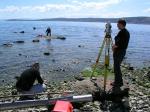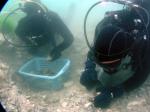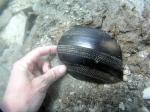Summary (English)
The aim of the rescue excavations, which took place from 11th to 30th April and from 9th to 21st May 2005, was to research the route of the sewage exhaust pipe in order to protect possible underwater archaeological finds.
The area of the planned underwater construction is located near the mouth of the creak, west of the beach and a small pier. The construction of the exhaust pipe is planned in the length of 92 m, measured from the coast in the south-southeast direction. Rescue archaeological excavations take place between the tenth and sixtieth meter of the route, on all places where the configuration of the terrain allowed and where the presence of archaeological finds was presumed. The route of the exhaust pipe was marked with a rope, along which an auxiliary metal net consisting of two or three squares (2×2 m) was placed. The auxiliary net was moved along the east and west sides of the axis, depending on the archaeological excavations.
At the 37.5 to 38.7 meters of the trench a solid rock that stretches almost parallel to the coast has been registered. During the excavation, north of the mentioned rock, a cultural layer with a thickness of 75 cm to 120 cm was found, while the cultural layer in the trenches south of the rock turned out to be much shallower (up to 40 cm). Archaeological finds appear up to 52 meters, after which the sterile muddy sea floor continues. Between the seventeenth and twenty-third meter, a group of stone blocks was found, which partly exceeded the surface of the sea floor. These building stone blocks were impossible to determine what kind of construction they belonged to.
Among the finds are fragments of fine ceramics, fragments of glass vessels, complete or partially damaged oil lamps, bone needles, a gold pendant for a necklace, a bronze ring, fragments of stone objects and fragments of amphorae and other coarser ceramic material. A fragment of a stone inscription was found, probably a tombstone, fragments of building materials such as tegulae, imbrices and stone mosaic tesserae, as well as a large quantity of animal bones, walnut shells and olive pits. In square 2, a well-preserved wooden comb was found, and in square 10, a half of a wooden pulley. A large number of nails and lead weights were among the metal finds.
By the results of the excavations, during which the entire area of the planned route of the sewer exhaust pipe was researched, this area was intensively used during the first centuries AD (I. Radić Rossi 2006, Hrvatski arheološki godišnjak 2/2005, 355–356).
- Irena Radić Rossi
Director
- Irena Radić Rossi
Team
Research Body
- Muzej grada Kaštela
- Odjel za arheologiju Sveučilišta u Zadru
- Odjel za podvodnu arheologiju Hrvatskoga restauratorskog zavoda






![Download [PDF]](/excavation/skins/fasti/images/results/download_sml.png)

